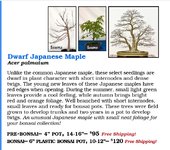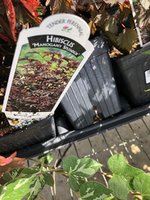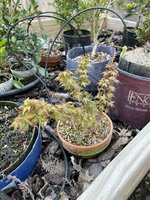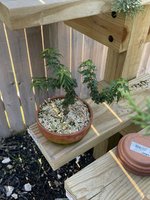Canada Bonsai
Chumono
- Messages
- 655
- Reaction score
- 2,292
There are maple societies where one can easily learn about cultivar process and preservation, and there is a large body of scholarship on Acer palmatum taxonomy that can be useful reading. But one need not focus on Acer palmatum at all; the core concept of 'cultivar' (regardless of species) goes back at least 2000 years and basic but sufficient descriptions can be found in most 101-textbooks. This is entry-level knowledge, and it is clear that some people have simply not done the required reading and would rather troll people far more knowledgeable on the topic than them.
This question comes up often, but in most cases people quickly learn and understand that it was a mistake to try to assign a cultivar name to a specific Acer palmatum specimen based on observation alone. Even if one had attained the expertise and experience of Vertrees (for example), that is simply not how cultivar assignment works. In fact, doing so can have legal consequences; there have been several massive and well-known lawsuits made public in this domain as well as countless private cases (some involving people that I know well). Yes, the process begins by initially selecting observable traits (in most instances), but once chosen and instated as a cultivar only specific propagation methods can be used to perpetuate and multiply that cultivar (once cannot walk around and 'find' them). One does not identify pre-existing specimens as a given cultivar based on observable traits (except in very specific circumstances that do not apply here).
By assigning cultivars to plants based on one's opinion you are putting at risk the purity of the cultivar: for example, what happens if you sell the plant? What happens if you propagate the plant? What happens if 10 years from now you've forgotten how that plant came to have its name on that little tag you made and now you now go ahead and assume that the plant is in fact the cultivar that the tag says it is, rather than it being the case that it simply might be that cultivar? What happens if you die and the plant somehow ends up in the hands of one of the biggest Japanese maple propagation nurseries in the world? and so on.
There is also question as to why you would want to assign a cultivar name to a specific Acer palmatum specimen anyways:
If your intention is to enjoy a Japanese Maple there really is no need to even ask the question. It's important to keep in mind that the assignment of a name/cultivar to genetic strains is from the start all quite arbitrary: it is intended to preserve a specific set of traits based mostly on the observable qualities of the leaf and/or growth habit of a plant. But how/why was one seedling chosen to be 'Deshojo' and not its neighbouring seedling? Would you be less happy if your neighbour had a 'Deshojo' and you had a tree nearly identical to it? Are names that important if one is happy with what one has? If there was a big pink maple growing in my yard I would not care if it was a 'Beni Chidori' or not.
That said, the somewhat arbitrary nature of this initial assignment of a cultivar name to a genetic strain does not undermine the fact that there is nonetheless tremendous value in preserving that set of traits (and in doing so without the interference of guess work). For example, one reason this is important is so that cultivars can be exchanged and people can know what to expect. Imagine going to a nursery and asking for "a smallish one with redish leaves and like pointy lobes but not too pointy kind of and that is red and then greenish-bronze and in the fall is kind of like orangy-red and that grows kind of upwards but also outwards but not a lot".
It might also be helpful to know that in Japan it is standard practice for pre-bonsai nurseries to grow seeds from a cultivar (for example), and then observe and keep the best ones to train as bonsai. With this approach, these seedlings will never be 'X-cultivar', and it does not matter. In most cases they don't even go through the trouble of labelling the seedlings as 'seedlings of X-cultivar'. They just are what they are. If they have the traits that are appropriate for bonsai then that's enough information.
In Japan there are also many varieties whose name is based on geographical location instead of 'cultivar' as we know it. Unfortunately, once the plants have arrived in North America these terms are sometimes mistaken as cultivar names which causes chaos for producers and consumers alike: who has the 'real' one and who has the 'fake' one becomes a very common, and very ridiculous, debate.
Edit: @Bonsai Nut it's funny that the test you proposed was also a trap. Why would somebody who was certain name 10 cultivars? Shouldn't naming just 1 suffice?
This question comes up often, but in most cases people quickly learn and understand that it was a mistake to try to assign a cultivar name to a specific Acer palmatum specimen based on observation alone. Even if one had attained the expertise and experience of Vertrees (for example), that is simply not how cultivar assignment works. In fact, doing so can have legal consequences; there have been several massive and well-known lawsuits made public in this domain as well as countless private cases (some involving people that I know well). Yes, the process begins by initially selecting observable traits (in most instances), but once chosen and instated as a cultivar only specific propagation methods can be used to perpetuate and multiply that cultivar (once cannot walk around and 'find' them). One does not identify pre-existing specimens as a given cultivar based on observable traits (except in very specific circumstances that do not apply here).
By assigning cultivars to plants based on one's opinion you are putting at risk the purity of the cultivar: for example, what happens if you sell the plant? What happens if you propagate the plant? What happens if 10 years from now you've forgotten how that plant came to have its name on that little tag you made and now you now go ahead and assume that the plant is in fact the cultivar that the tag says it is, rather than it being the case that it simply might be that cultivar? What happens if you die and the plant somehow ends up in the hands of one of the biggest Japanese maple propagation nurseries in the world? and so on.
There is also question as to why you would want to assign a cultivar name to a specific Acer palmatum specimen anyways:
If your intention is to enjoy a Japanese Maple there really is no need to even ask the question. It's important to keep in mind that the assignment of a name/cultivar to genetic strains is from the start all quite arbitrary: it is intended to preserve a specific set of traits based mostly on the observable qualities of the leaf and/or growth habit of a plant. But how/why was one seedling chosen to be 'Deshojo' and not its neighbouring seedling? Would you be less happy if your neighbour had a 'Deshojo' and you had a tree nearly identical to it? Are names that important if one is happy with what one has? If there was a big pink maple growing in my yard I would not care if it was a 'Beni Chidori' or not.
That said, the somewhat arbitrary nature of this initial assignment of a cultivar name to a genetic strain does not undermine the fact that there is nonetheless tremendous value in preserving that set of traits (and in doing so without the interference of guess work). For example, one reason this is important is so that cultivars can be exchanged and people can know what to expect. Imagine going to a nursery and asking for "a smallish one with redish leaves and like pointy lobes but not too pointy kind of and that is red and then greenish-bronze and in the fall is kind of like orangy-red and that grows kind of upwards but also outwards but not a lot".
It might also be helpful to know that in Japan it is standard practice for pre-bonsai nurseries to grow seeds from a cultivar (for example), and then observe and keep the best ones to train as bonsai. With this approach, these seedlings will never be 'X-cultivar', and it does not matter. In most cases they don't even go through the trouble of labelling the seedlings as 'seedlings of X-cultivar'. They just are what they are. If they have the traits that are appropriate for bonsai then that's enough information.
In Japan there are also many varieties whose name is based on geographical location instead of 'cultivar' as we know it. Unfortunately, once the plants have arrived in North America these terms are sometimes mistaken as cultivar names which causes chaos for producers and consumers alike: who has the 'real' one and who has the 'fake' one becomes a very common, and very ridiculous, debate.
Edit: @Bonsai Nut it's funny that the test you proposed was also a trap. Why would somebody who was certain name 10 cultivars? Shouldn't naming just 1 suffice?
Last edited:




